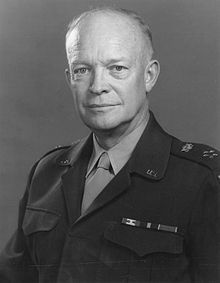Dwight David Eisenhower | |
|---|---|
 Eisenhower in 1947 | |
| Nickname(s) | Ike |
| Born | October 14, 1890 Denison, Texas |
| Died | March 28, 1969 Washington, D.C. |
| Allegiance | United States |
| Service | United States Army |
| Years of service | 1915 – 1953 1961 – 1969 |
| Rank | General of the Army |
| Commands | Supreme Allied Commander Europe Chief of Staff of the United States Army Military Governor of the U.S. Occupation Zone in Germany Supreme Commander Allied Expeditionary Force in Western Europe Commanding General, European Theater of Operations Commander-in-Chief, Allied Forces in North Africa |
| Battles / wars | See battles |
| Awards | Navy Distinguished Service Medal Army Distinguished Service Medal (5) Legion of Merit |
| Other work | President of Columbia University, NY President of the United States of America |
| ||
|---|---|---|
|
World War II
34th President of the United States
First Term
Second Term
Presidential campaigns Post-Presidency
|
||
The military career of Dwight D. Eisenhower began in June 1911, when Eisenhower took the oath as a cadet at the United States Military Academy at West Point. He graduated from West Point and was commissioned as a second lieutenant in the United States Army in June 1915, as part of "the class the stars fell on". He rose through the ranks over the next thirty years and became one of the most important Allied generals of World War II, being promoted to General of the Army in 1944. Eisenhower retired from the military after winning the 1952 presidential election, though his rank as General of the Army was restored by an act of Congress in March 1961.
After graduating from the United States Military Academy in 1915, Eisenhower was assigned to the 19th Infantry Regiment at Fort Sam Houston. He served in the continental United States throughout World War I, ending the war as the commander of a battalion that trained tank crews. After the war, he served as part of a Transcontinental Motor Convoy that traveled across the continental United States. In 1922, he was transferred to the Panama Canal Zone, where he served under General Fox Conner. He then served on the American Battle Monuments Commission under the command of General John J. Pershing. In 1929, he became the executive officer to General George Van Horn Moseley, who served on the staff of Assistant Secretary of War Frederick Huff Payne. In 1935, Eisenhower accompanied General Douglas MacArthur to the Philippines, where they served as military advisers charged with developing the Philippine Army. Eisenhower returned to the United States in 1939 and took part in the Louisiana Maneuvers as the chief of staff to General Walter Krueger.
After the United States entered World War II, General George C. Marshall assigned Eisenhower to the War Plans Division in Washington, D.C. Eisenhower became the commander of American forces in Britain in June 1942 and was assigned to lead Operation Torch, the Allied invasion of French North Africa. After the success of Operation Torch, Eisenhower led the successful Allied invasion of Tunisia, forcing the surrender of all Axis forces in May 1943. Eisenhower led the opening phases of the Italian campaign, but was subsequently assigned to lead the Allied invasion of Western Europe in December 1943. He served as the supreme commander of Operation Overlord, the Allied invasion of Normandy, and took command of subsequent operations in France. Following the success of Operation Overlord, the Allies quickly took control of much of Western Europe, but the Germans launched a major counter-attack in the Battle of the Bulge. German resistance quickly collapsed following the Allied victory in that battle, and Eisenhower accepted the surrender of Germany in May 1945.
After the war, Eisenhower served as the commander of the American zone of occupation in Germany. In November 1945, he succeeded Marshall as the chief of staff of the United States Army. Eisenhower left active duty in 1948 to become the president of Columbia University, but rejoined the army in 1951 to become the first supreme commander of NATO. He left the army once again in 1952 to run for President of the United States; his presidential candidacy was successful and he served as president from January 1953 to January 1961.

